Study of the Transcription Effects of Pressing Dies with Ultrasonic Polishing on Glass Molding
Abstract
:1. Introduction
2. Methods
2.1. Optical Design
2.2. Pressing Die of Glass Molding
2.3. Material
2.4. Glass Molding Process
2.5. Evaluating the Precision of Pressing Dies and Transcription Effects in the Glass Molding
3. Results
3.1. The Transcription Effects of Temperature and Pressing Force on the Surface Roughness of MLA
3.2. Polishing Effects with or without Ultrasonic Polishing on Surface Roughness and Material Removal
3.3. Polishing Effects of Diamond Abrasive on the Surface Roughness and Material Removal
3.4. Transcription Effects of the Pressing Dies
4. Conclusions
- Excellent transcription effects could be obtained when the parameter of the pressing force was 250 N and the working temperature was set to 690 °C, whereby the transcription ratio of the pressing die topography to the MLA surface could reach 99% in PGM.
- The die surface with ultrasonic polishing was smoother and could produce a larger amount of material removal than the die surface without ultrasonic finishing. According to the results, the RIR with ultrasonic polishing of the pressing die could reach 90% when using the abrasive of mesh #8000, whereas the RIR without ultrasonic finishing of the pressing die only yielded a low value of 33%.
- The MLA made using the pressing die with a surface roughness 0.08 µm Ra could not transform the Gauss-distributed spotlight into a uniform straight line by virtue of its poor transparency. However, the MLA made using the pressing die with a surface roughness of 0.023 µm Ra in PGM achieved a uniform straight line from the Gauss spotlight emitted by the laser pen.
- The temperature and pressure are the key parameters of the glass molding. In this study, the MLA stuck easily to the pressing die at a high temperature (over 690 °C), whereas a low temperature and low pressure in PGM could induce a bad transcription effect, and the MLA was ruptured at high pressure (270 N).
Author Contributions
Funding
Institutional Review Board Statement
Informed Consent Statement
Data Availability Statement
Acknowledgments
Conflicts of Interest
References
- Meuret, Y.; Vangiel, B.; Christiaens, F.; Thienpont, H. Efficient illumination in LED-based projection system using lenslet integrators. Opt. Eng. 2006, 619605–619620. [Google Scholar] [CrossRef]
- Pan, J.-W.; Wang, C.-M.; Lan, H.-C.; Sun, W.-S.; Chang, J.-Y. Homogenized LED-illumination using microlens arrays for a pocket-sized projector. Opt. Express 2007, 15, 10483–10491. [Google Scholar] [CrossRef] [PubMed]
- Han, J.; Li, L.; Lee, W. Machining of Lenticular Lens Silicon Molds with a Combination of Laser Ablation and Diamond Cutting. Micromachines 2019, 10, 250. [Google Scholar] [CrossRef] [PubMed] [Green Version]
- Huang, C.-Y.; Chen, C.-C.; Chang, K.-S.; Chou, H.-Y.; Hsu, W.-Y.; Lee, T.-X. Fabrication of a hybrid optical micro-component with a thermosetting polymer and glass. In Proceedings of the International Conference on Optics in Precision Engineering and Nanotechnology (icOPEN2013), Singapore, 22 June 2013; pp. 87693O–87693O-7. [Google Scholar] [CrossRef]
- Vu, A.T.; Grunwald, T.; Bergs, T. Thermo-viscoelastic Modeling of Nonequilibrium Material Behavior of Glass in Nonisothermal Glass Molding. Procedia Manuf. 2020, 47, 1561–1568. [Google Scholar] [CrossRef]
- Zhang, Z.; Ming, W.; Zhang, Y.; Yin, L.; Xue, T.; Yu, H.; Chen, Z.; Liao, D.; Zhang, G. Analyzing sustainable performance on high-precision molding process of 3D ultra-thin glass for smart phone. J. Clean. Prod. 2020, 255, 120196. [Google Scholar] [CrossRef]
- Wang, A.C.; Yan, B.H.; Li, X.T.; Huang, F.Y. Use of micro ultrasonic vibration lapping to enhance the precision of microholes drilled by micro electro-discharge machining. Int. J. Mach. Tools Manuf. 2002, 42, 915–923. [Google Scholar] [CrossRef]
- Yan, B.; Wang, A.; Huang, C.; Huang, F. Study of precision micro-holes in borosilicate glass using micro EDM combined with micro ultrasonic vibration machining. Int. J. Mach. Tools Manuf. 2002, 42, 1105–1112. [Google Scholar] [CrossRef]
- Kobayashi, N.; Wu, Y.; Nomura, M.; Sato, T. Precision treatment of silicon wafer edge utilizing ultrasonically assisted polishing technique. J. Mater. Process. Technol. 2008, 201, 531–535. [Google Scholar] [CrossRef]
- Tsai, M.-Y.; Yang, W.-Z. Combined ultrasonic vibration and chemical mechanical polishing of copper substrates. Int. J. Mach. Tools Manuf. 2012, 53, 69–76. [Google Scholar] [CrossRef]
- Zhao, Q.; Sun, Z.; Guo, B. Material removal mechanism in ultrasonic vibration assisted polishing of micro cylindrical surface on SiC. Int. J. Mach. Tools Manuf. 2016, 103, 28–39. [Google Scholar] [CrossRef]
- Guo, B.; Zhao, Q. Ultrasonic vibration assisted grinding of hard and brittle linear micro-structured surfaces. Preci. Eng. 2017, 48, 98–106. [Google Scholar] [CrossRef]
- Yu, T.; An, J.; Yang, X.; Bian, X.; Zhao, J. The study of ultrasonic vibration assisted polishing optical glass lens with ultrasonic atomizing liquid. J. Manuf. Process. 2018, 34, 389–400. [Google Scholar] [CrossRef]
- Li, Y.; Wu, Y.; Zhou, L.; Fujimoto, M. Vibration-assisted dry polishing of fused silica using a fixed-abrasive polisher. Int. J. Mach. Tools Manuf. 2014, 77, 93–102. [Google Scholar] [CrossRef]
- Suzuki, H.; Moriwaki, T.; Okino, T.; Ando, Y. Development of Ultrasonic Vibration Assisted Polishing Machine for Micro Aspheric Die and Mold. CIRP Ann. 2006, 55, 385–388. [Google Scholar] [CrossRef]
- Suzuki, H.; Hamada, S.; Okino, T.; Kondo, M.; Yamagata, Y.; Higuchi, T. Ultraprecision finishing of micro-aspheric surface by ultrasonic two-axis vibration assisted polishing. CIRP Ann. 2010, 59, 347–350. [Google Scholar] [CrossRef]

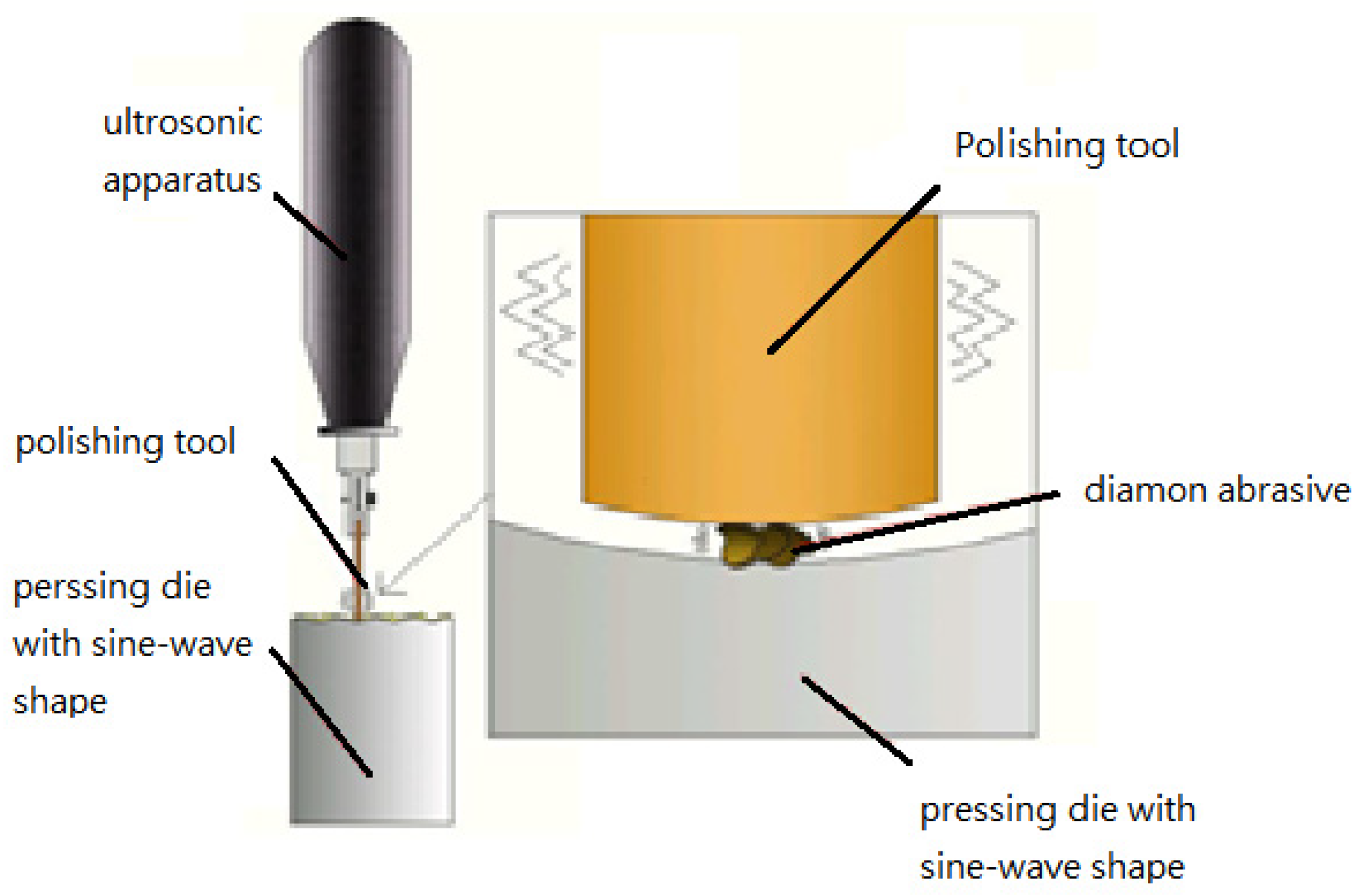

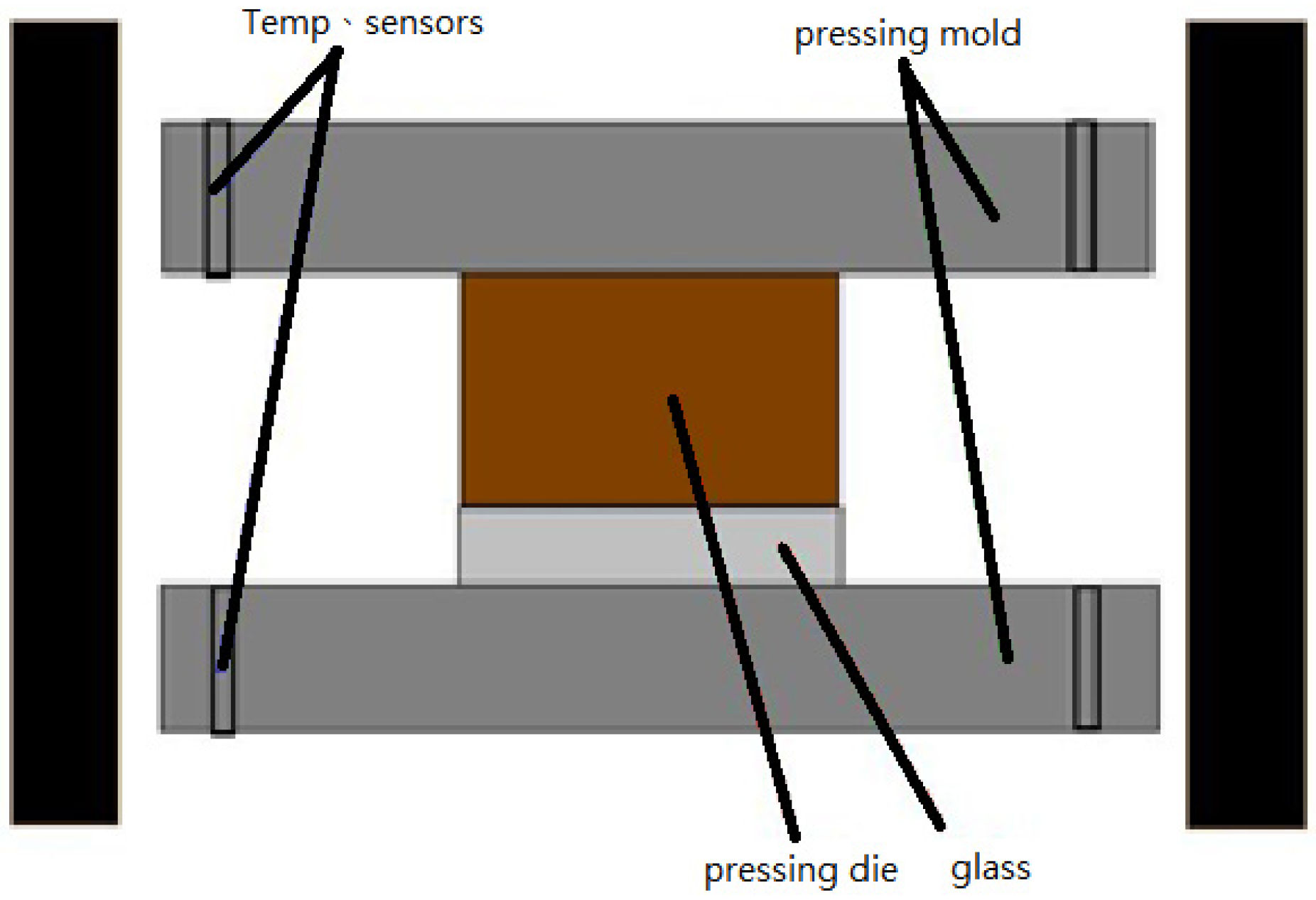

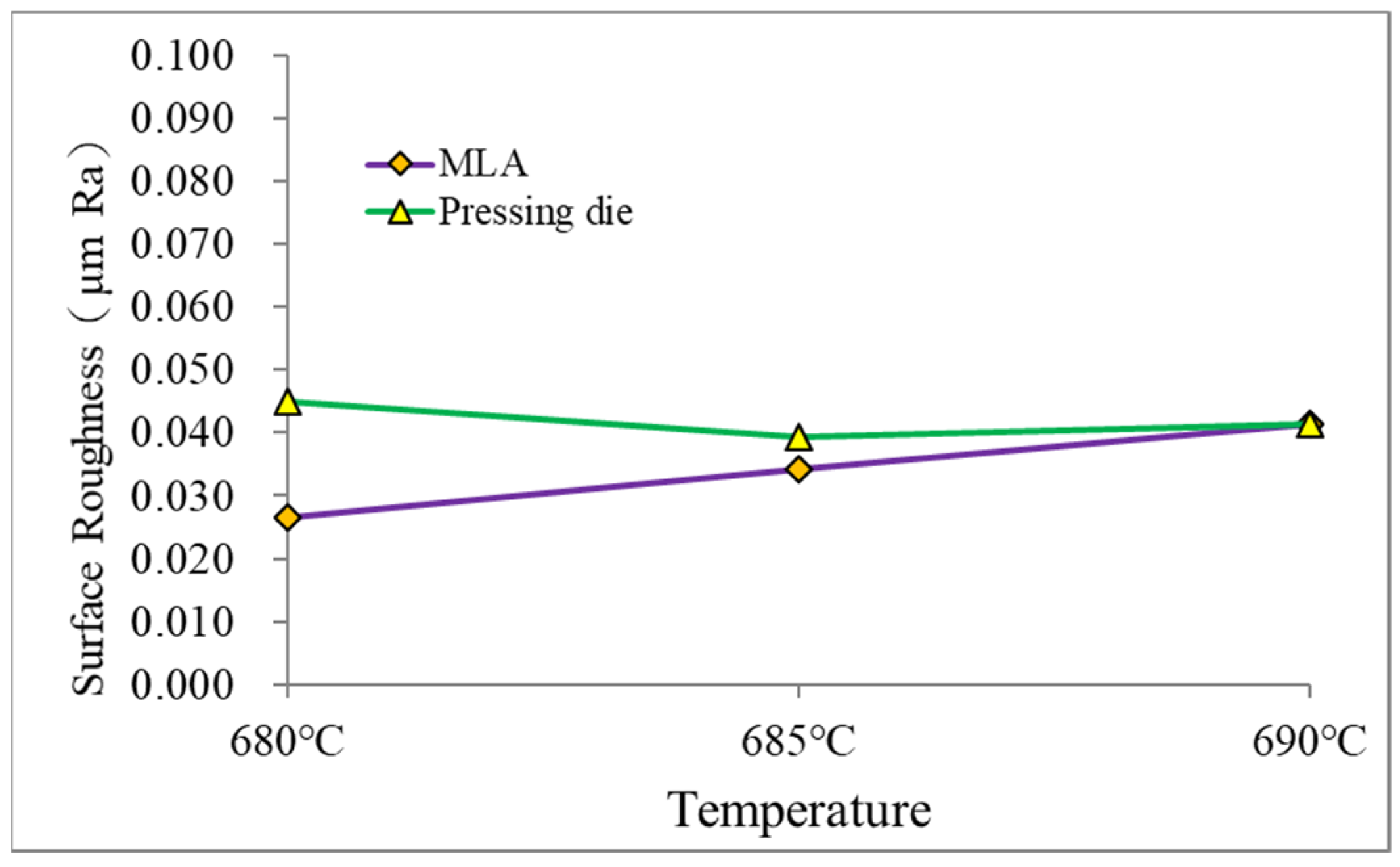
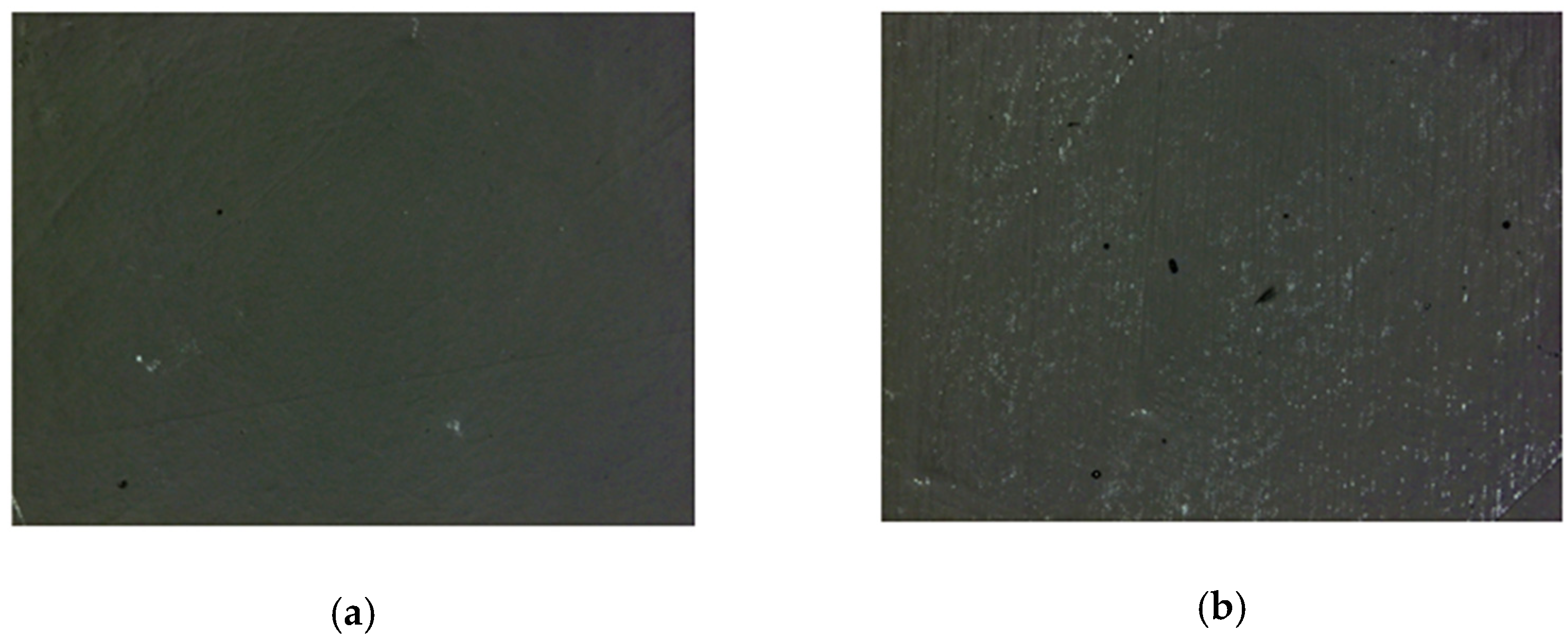
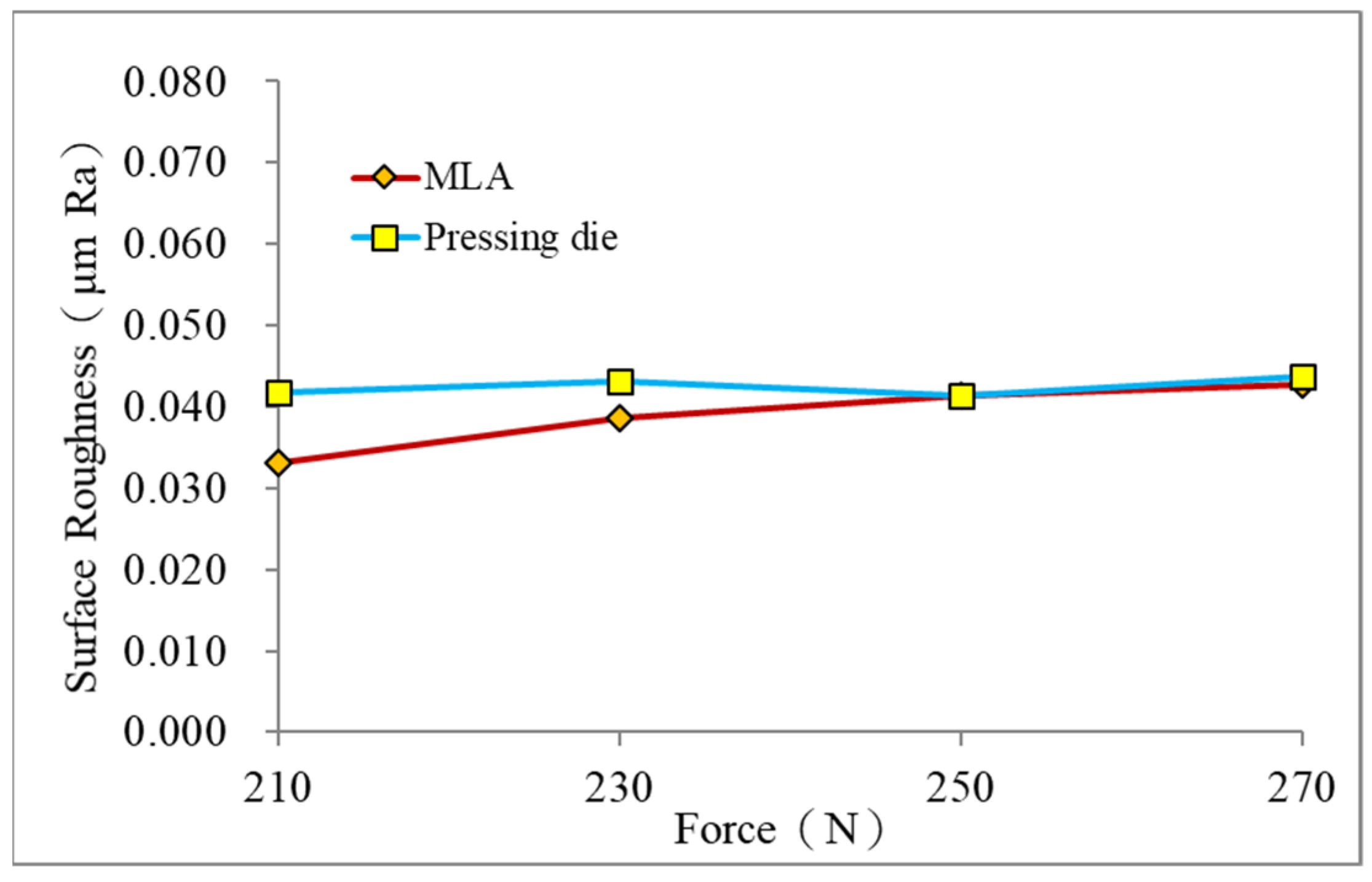
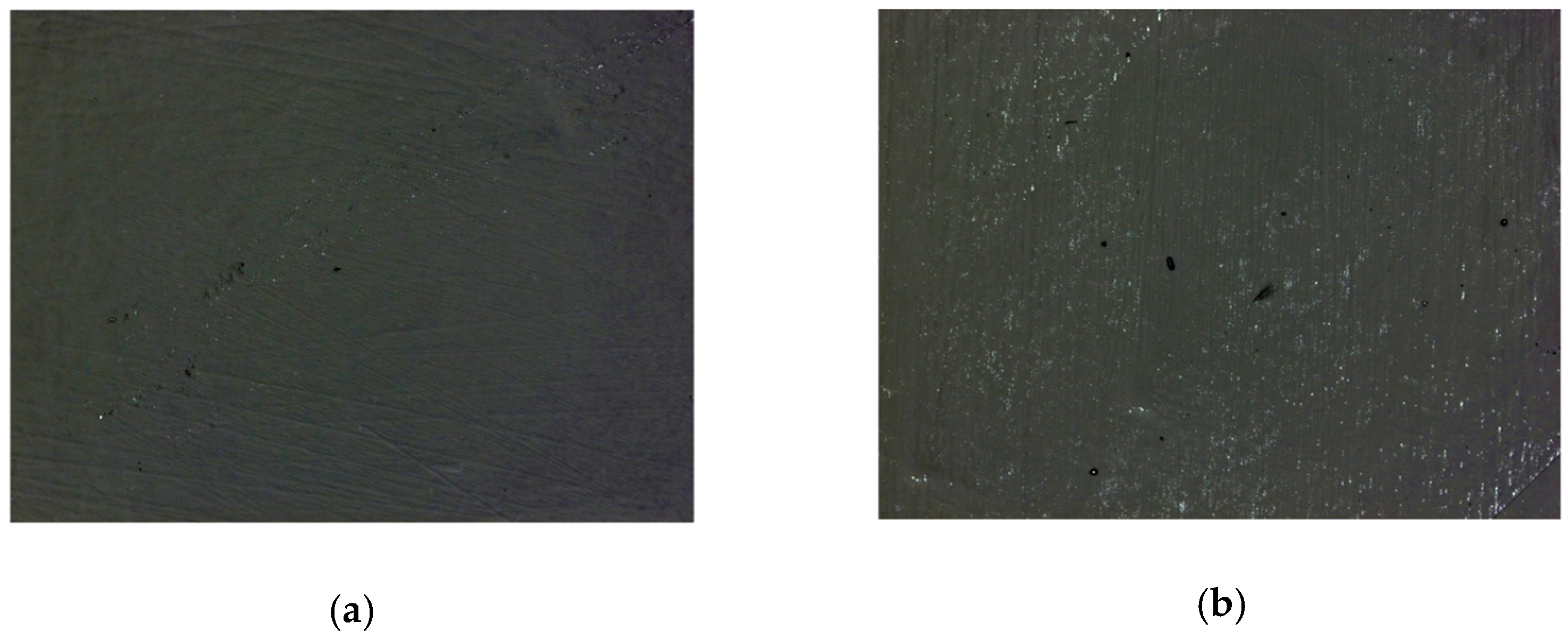
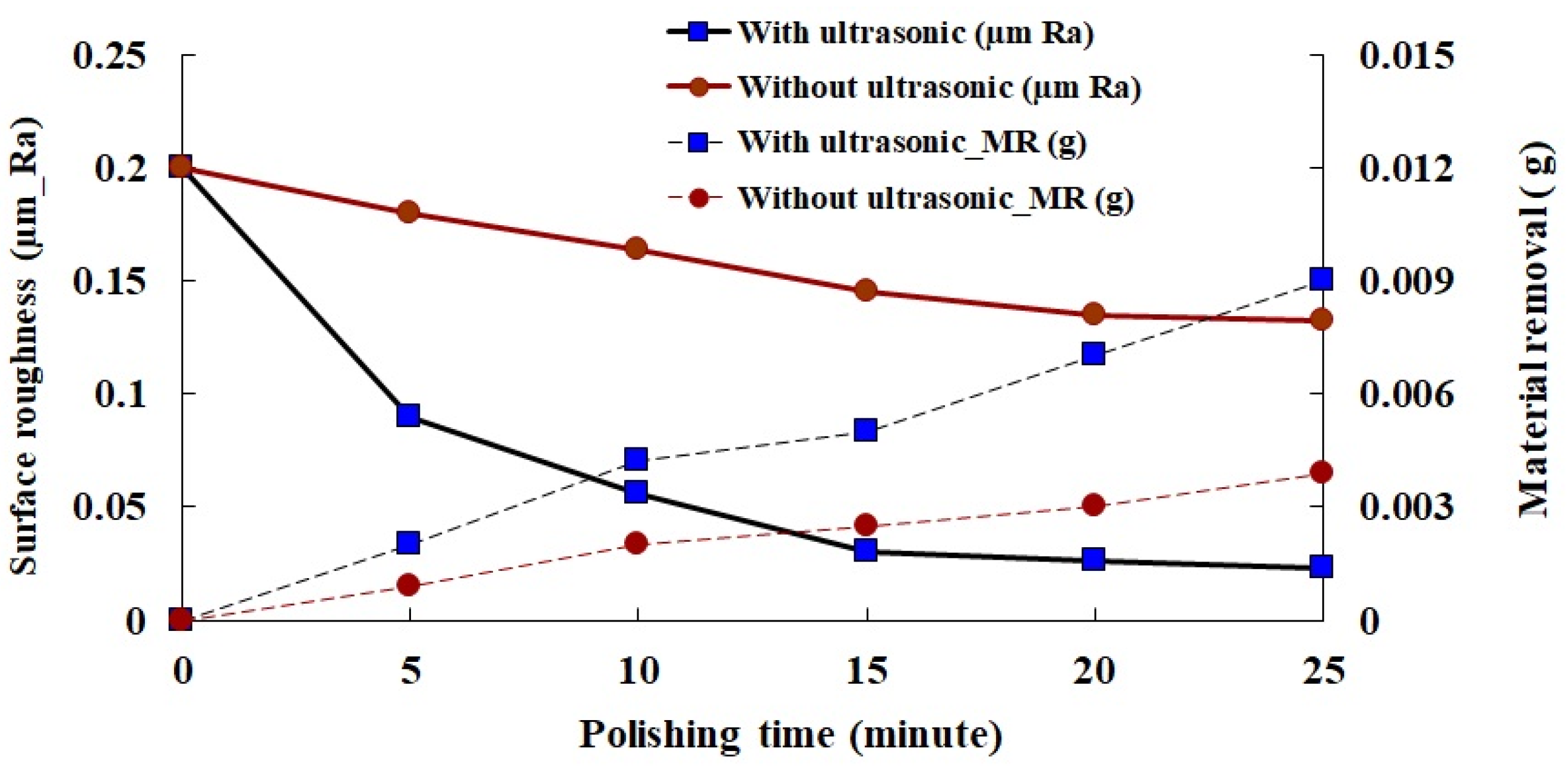
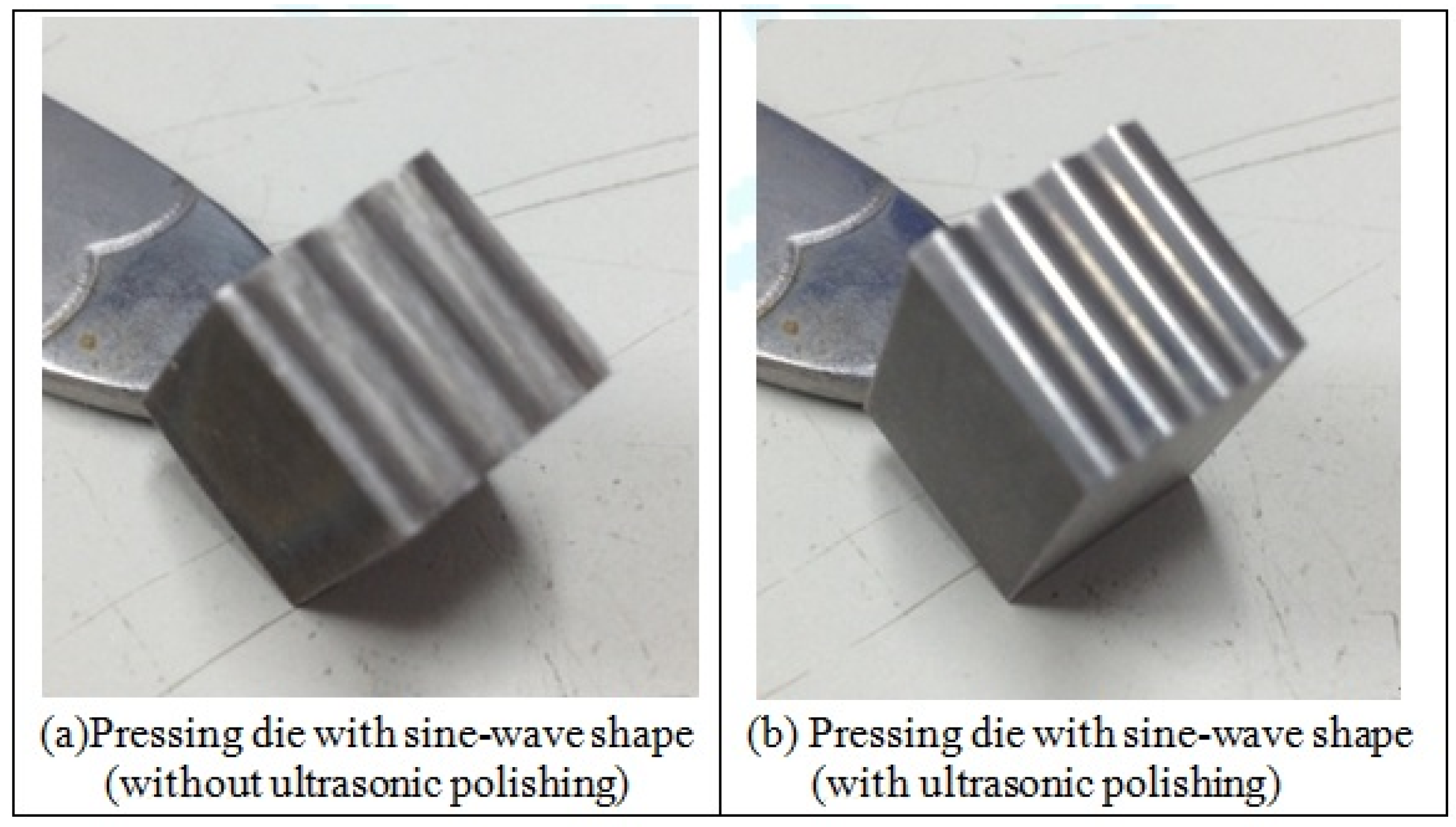
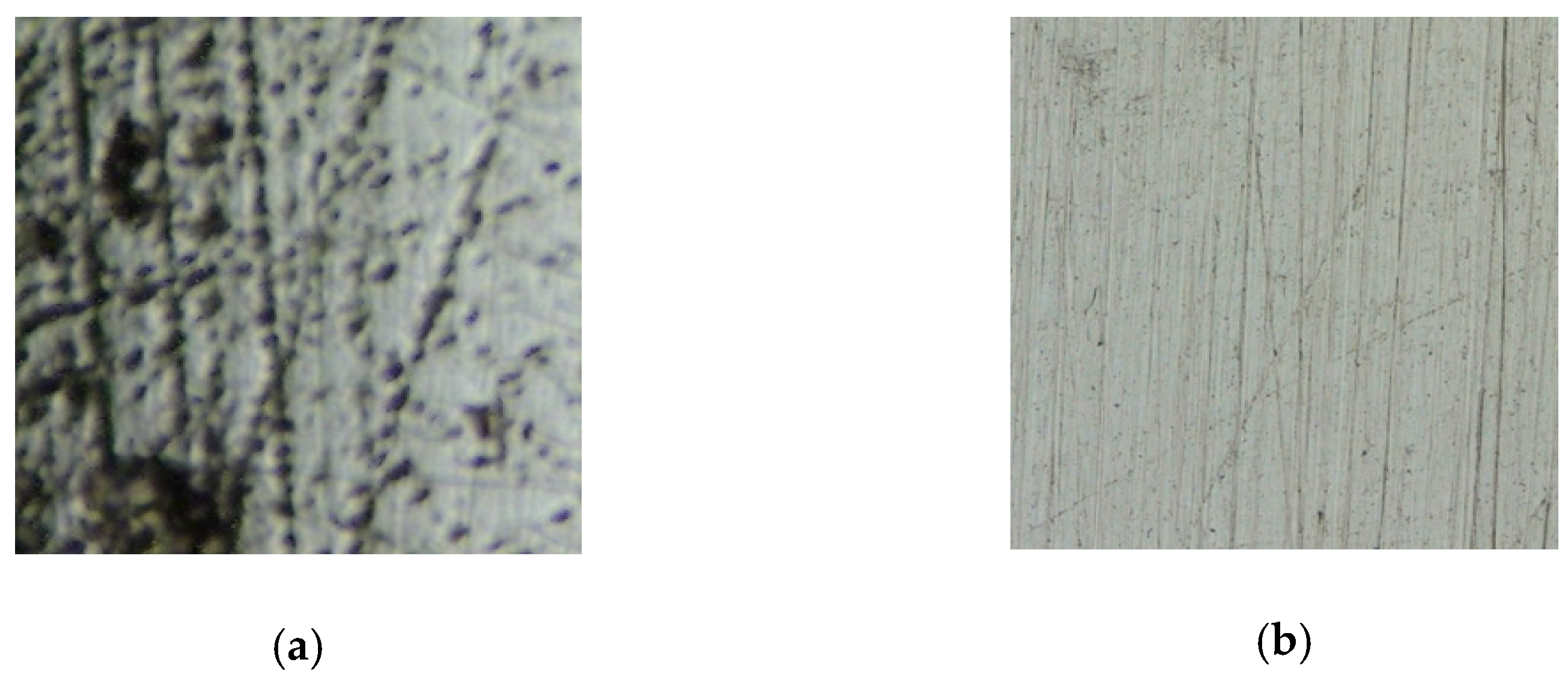
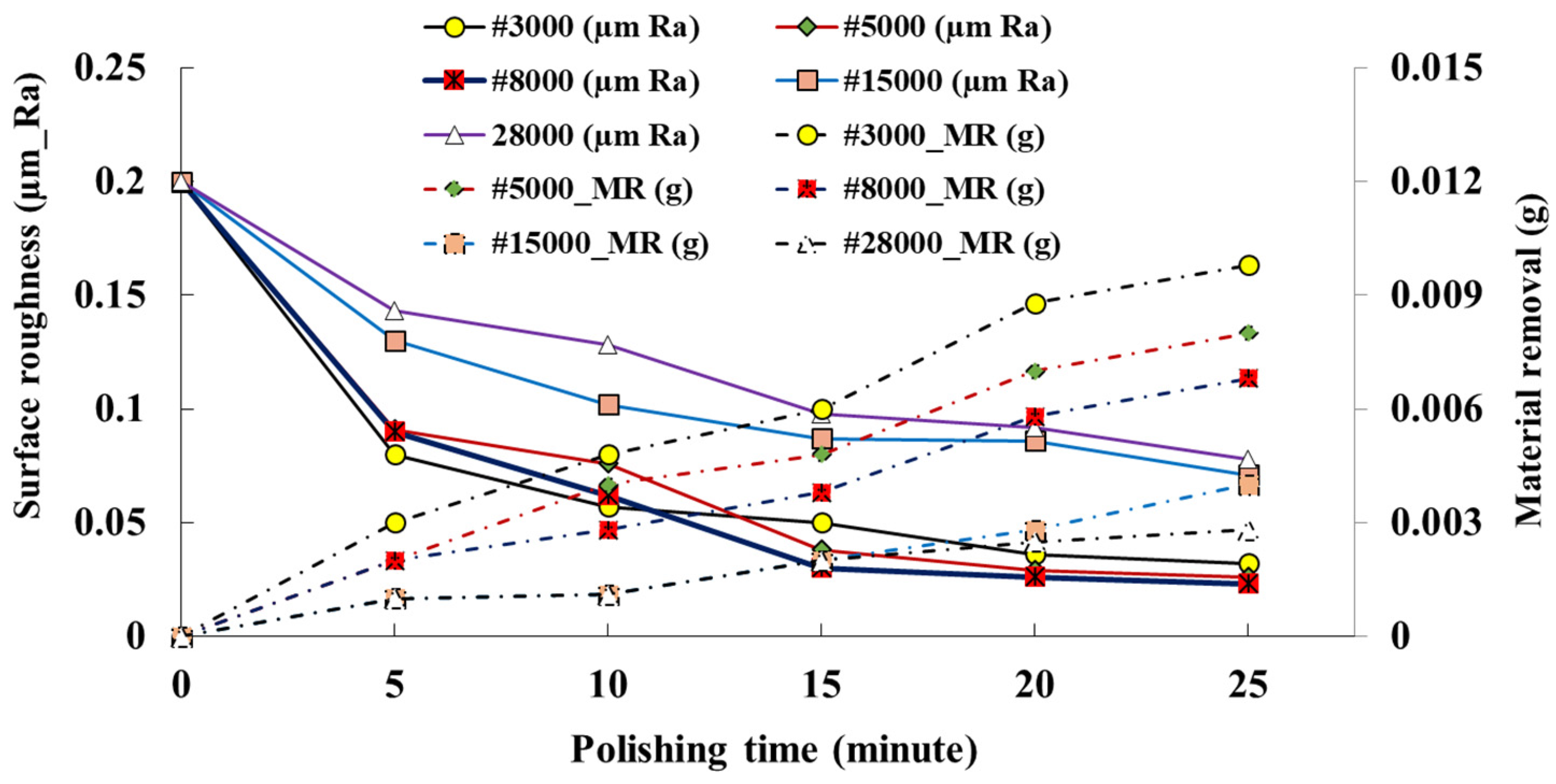
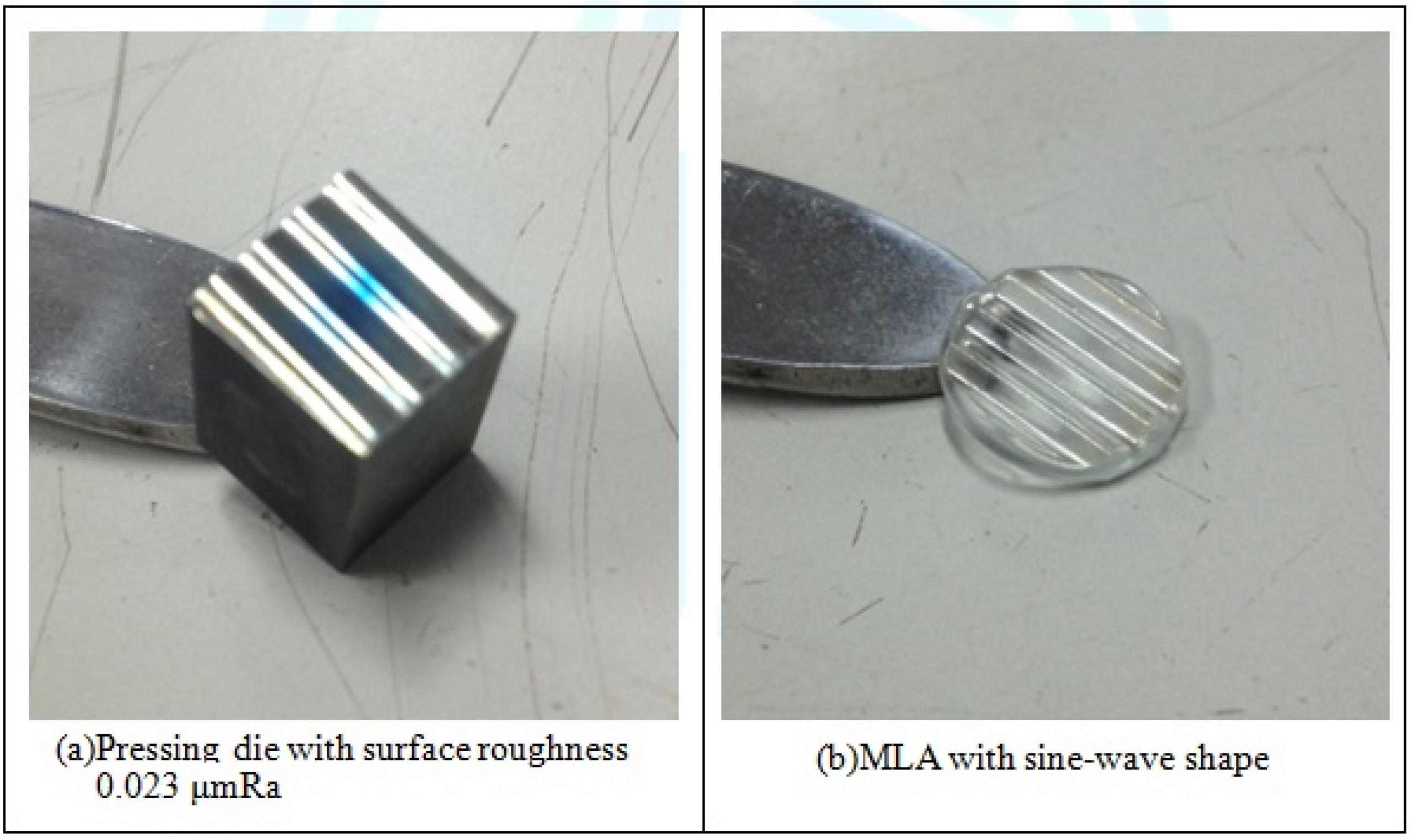
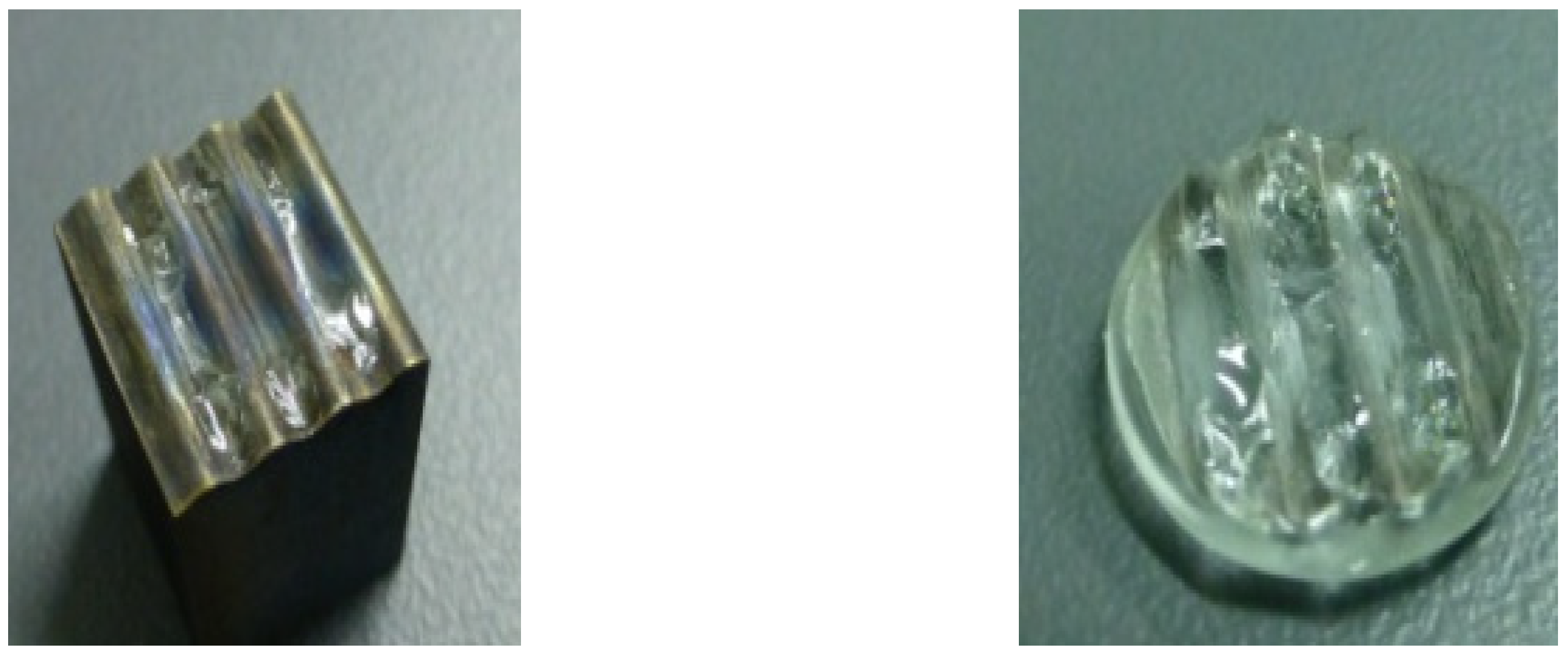
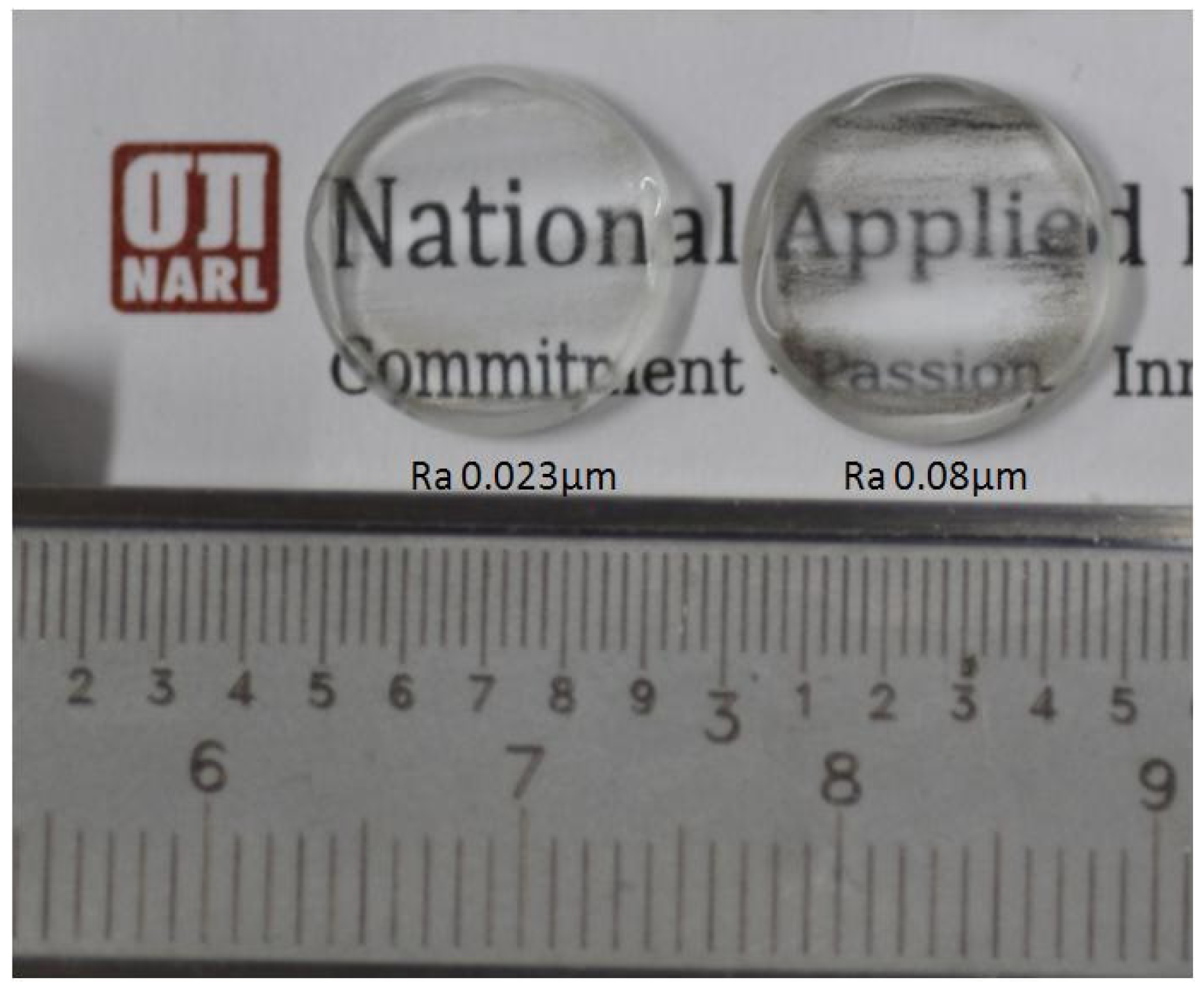

| Physical Properties | Parameters |
|---|---|
| Glass transition temperature, Tg (°C) | 564 |
| Thermal expansion coefficient (ppm/K) | 9.5 |
| Refractive index at 20 °C (nD) | 1.52 |
| Dispersion at 20 °C, 140 × (nF − nC) | 87.7 |
Publisher’s Note: MDPI stays neutral with regard to jurisdictional claims in published maps and institutional affiliations. |
© 2021 by the authors. Licensee MDPI, Basel, Switzerland. This article is an open access article distributed under the terms and conditions of the Creative Commons Attribution (CC BY) license (https://creativecommons.org/licenses/by/4.0/).
Share and Cite
Cheng, K.-C.; Huang, C.-Y.; Hung, J.-C.; Wang, A.-C.; Lin, Y.-C. Study of the Transcription Effects of Pressing Dies with Ultrasonic Polishing on Glass Molding. Processes 2021, 9, 2083. https://doi.org/10.3390/pr9112083
Cheng K-C, Huang C-Y, Hung J-C, Wang A-C, Lin Y-C. Study of the Transcription Effects of Pressing Dies with Ultrasonic Polishing on Glass Molding. Processes. 2021; 9(11):2083. https://doi.org/10.3390/pr9112083
Chicago/Turabian StyleCheng, Ken-Chuan, Chien-Yao Huang, Jung-Chou Hung, A-Cheng Wang, and Yan-Cherng Lin. 2021. "Study of the Transcription Effects of Pressing Dies with Ultrasonic Polishing on Glass Molding" Processes 9, no. 11: 2083. https://doi.org/10.3390/pr9112083
APA StyleCheng, K.-C., Huang, C.-Y., Hung, J.-C., Wang, A.-C., & Lin, Y.-C. (2021). Study of the Transcription Effects of Pressing Dies with Ultrasonic Polishing on Glass Molding. Processes, 9(11), 2083. https://doi.org/10.3390/pr9112083








